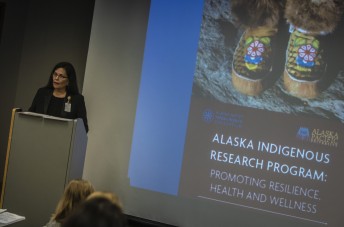Category: Health Research and Data

Colorectal cancer is one of the most frequently diagnosed cancers among Alaska Native people. Alaska Native men and women are two times more likely to get diagnosed with colon cancer than non-Natives. But there is hope, it is also one of the most preventable and treatable types of cancer. An important step to preventing colon cancer is to be screened. It is recommended that Alaska Native people should start screening at age 40. If you have a family history of ...

Since 2019, the Alaska Native Tribal Health Consortium (ANTHC) and the Alaska Pacific University (APU) have hosted the Alaska Indigenous Research Program (AKIRP): Promoting Resilience, Health and Wellness. The 5th Annual Alaska Indigenous Research Program will be held May 8-26, 2023 at the Alaska Pacific University in Anchorage, Alaska. A limited number of scholarships to cover travel and registration fees are available. The goal of AKIRP is to increase the health research capacity of Alaska Native and American Indian people and communities by ...
The Alaska Native Epidemiology Center (EpiCenter) has just published two new reports, available on the EpiCenter website. You can contact the EpiCenter for printed copies. Alaska Native Mortality Report: 1980-2018 This report shows detailed information on the leading causes of death among Alaska Native people over time. Statistics are provided by age, gender, and by Tribal health service regions. Further information about life expectancy, years of potential life lost, excess death, and comparisons to U.S. all races mortality can be ...

The Spring 2021 Mukluk Telegraph newspaper is now online!Featuring these stories: ANMC staff celebrates our nurses!ANMC Surgical System technologyMental Health Awareness Month activities Also, check out these health tips: ATV SafetyBoating Safety Or this recipe for bok choy with moose stir-fry and a special recap of the Healthy Alaska Natives Foundation’s Raven’s Resilience Celebration. The Mukluk Telegraph is the official newspaper of the Alaska Native Tribal Health Consortium. We are continuously working to protect and care for our community throughout Alaska while we address the COVID-19 pandemic and ...

Approximately 3,300 homes in over 30 communities in rural Alaska lack in-home piped water, leading to low in-home water use. Community facilities, such as washeterias, help bridge gaps in household water access where piped water may not be immediately accessible. Washeterias are core and essential community facilities that play an important role in critical hygiene activities, such as bathing and laundry, for these locations and help increase sufficient water usage to protect health. Ease of water access and increased usage ...
Telemed Research Study Survey Participants Needed

Alaska has been a leader in telemedicine innovation and more recently with dramatically improved video teleconferencing capability. ANTHC is conducting research with patients who are 18 an older and diagnosed with a chronic disease and who are being seen by a specialist to complete a brief survey about telemedicine visits. The study is open to people meeting these eligibility criteria, whether you have used telemedicine services or not. Participation is voluntary. Volunteers will be given a small gift for participating. ...
